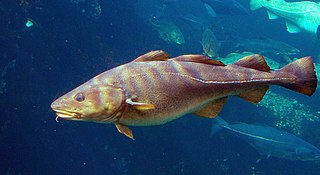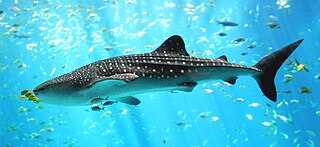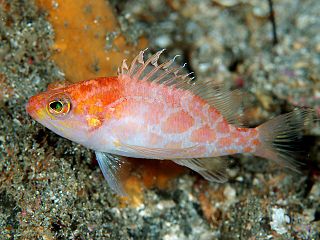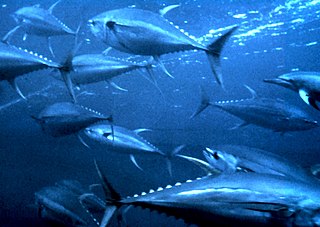
The Cyprinidae are the family of freshwater fish, collectively called cyprinids, that includes the carps, the true minnows, and their relatives. Also commonly called the "carp family", or "minnow family", Cyprinidae is the largest and most diverse fish family and the largest vertebrate animal family in general, with about 3,000 species of which only 1,270 remain extant, divided into about 370 genera. They range from about 12 mm to the 3-m Catlocarpio siamensis. The family belongs to the ostariophysian order Cypriniformes, of whose genera and species the cyprinids make up more than two-thirds. The family name is derived from the Ancient Greek kyprînos.

Cod is the common name for the demersal fish genus Gadus, belonging to the family Gadidae. Cod is also used as part of the common name for a number of other fish species, and one species that belongs to genus Gadus is commonly not called cod.

A tuna is a saltwater fish that belongs to the tribe Thunnini, a subgrouping of the Scombridae (mackerel) family. The Thunnini comprise 15 species across five genera, the sizes of which vary greatly, ranging from the bullet tuna up to the Atlantic bluefin tuna. The Atlantic bluefin averages 2 m (6.6 ft), and is believed to live up to 50 years.

"Sardine" and "pilchard" are common names that refer to various small, oily forage fish in the herring family Clupeidae. The term "sardine" was first used in English during the early 15th century and may come from the Mediterranean island of Sardinia, around which sardines were once abundant.

The Squaliformes are an order of sharks that includes about 126 species in seven families.

Carpet sharks are sharks classified in the order Orectolobiformes. Sometimes the common name "carpet shark" is used interchangeably with "wobbegong", which is the common name of sharks in the family Orectolobidae. Carpet sharks have five gill slits, two spineless dorsal fins, and a small mouth that does not extend past the eyes. Many species have barbels.

Stenodus leucichthys is a species of freshwater whitefish in the family Salmonidae. In the strict sense its natural distribution is restricted to the Caspian Sea basin, and it is known as beloribitsa. The beloribitsa is now considered extinct in the wild, but survives in cultured stocks.

The Syngnathidae is a family of fish which includes seahorses, pipefishes, and seadragons. The name is derived from Greek, σύν (syn), meaning "together", and γνάθος (gnathos), meaning "jaw". This fused jaw trait is something the entire family has in common.

Citharichthys is a genus of flatfish in the large-tooth flounder family, Paralichthyidae. They have both eyes on the left sides of their heads. They are native to the oceans around the Americas, with a single species, C. stampflii off the West African coast. Most are found in relatively shallow depths, but the genus also includes species found in deep water and species that enter fresh water.

Plectranthias is a genus of ray-finned fish in the subfamily Anthiinae, part of the family Serranidae, the groupers and sea basses. They are found in the Atlantic, Indian and Pacific Ocean.

Thunnus is a genus of ocean-dwelling, ray-finned bony fish from the mackerel family, Scombridae. More specifically, Thunnus is one of five genera which make up the tribe Thunnini – a tribe that is collectively known as the tunas. Also called the true tunas or real tunas, Thunnus consists of eight species of tuna, divided into two subgenera. The word Thunnus is the Middle Latin form of the Greek thýnnos – which is in turn derived from thynō. The first written use of the word was by Homer.

Zaniolepis is a genus of scorpaeniform fish native to the eastern Pacific Ocean. Z. frenata is known to have been a source of food to the Native American inhabitants of San Nicolas Island off the coast of southern California, United States during the Middle Holocene.

Lutjanidae, or snappers. are a family of perciform fish, mainly marine, but with some members inhabiting estuaries, feeding in fresh water. The family includes about 113 species. Some are important food fish. One of the best known is the red snapper.

An anchovy is a small, common forage fish of the family Engraulidae. Most species are found in marine waters, but several will enter brackish water, and some in South America are restricted to fresh water.

Fish are very diverse animals and can be categorised in many ways. This article is an overview of some of ways in which fish are categorised. Although most fish species have probably been discovered and described, about 250 new ones are still discovered every year. According to FishBase, 34,300 species of fish had been described as of September 2020. That is more than the combined total of all other vertebrate species: mammals, amphibians, reptiles and birds.

Leptochilichthys is a genus of marine smelts containing four species. Leptochilichthys is the only genus in the former family Leptochilichthyidae but is now included within the broader family Alepocephalidae.

Symphysanodon, also known as the slopefishes, is a genus of small marine fishes. Most are found in the Indo-Pacific, but three species, S. berryi, S. mona, and S. octoactinus, are found in the Western Atlantic. They are found on rocky reefs at depths of 50–700 m (160–2,300 ft). Traditionally, this genus is the only member of the family Symphysanodontidae, but in 2017 a new species, C. aureolateralis, was placed in its own genus Cymatognathus.

Odontanthias is a genus of marine ray-finned fish in the subfamily Anthiinae and family Serranidae. Depending on the exact species, they reach up to 10–22 cm (3.9–8.7 in) in standard length, and are brightly marked with pink and yellow. They are found at rocky reefs in deep water, mainly below 100 m (330 ft). The genus is almost entirely restricted to the Indo-Pacific; O. cauoh of the Saint Peter and Saint Paul Archipelago and O. hensleyi of the Caribbean are the only species known from outside the Indo-Pacific and evidence indicates that the latter belongs in Anthias.
Microbrotula is a genus of viviparous brotulas.
Echiodon is a genus of pearlfishes, with these currently recognized species:

















